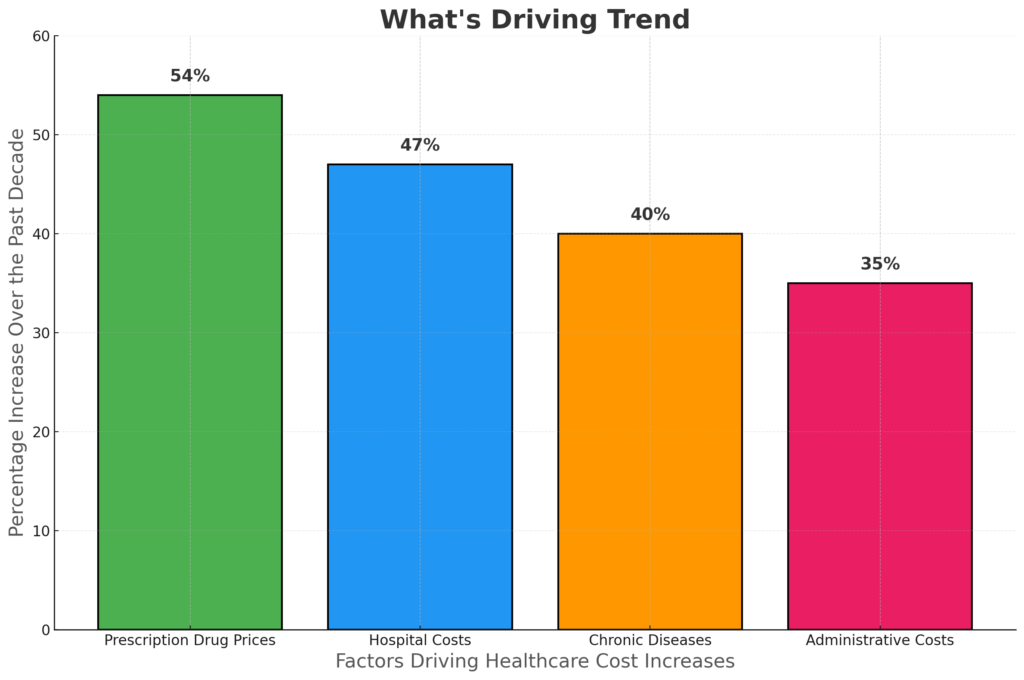On average, how much have your organization’s healthcare costs increased per year over the past few years? What is the long-term impact of addressing “trend”?
Trend Calculator
4%
1 Year Savings
$0
3 Year Savings
$0
5 Year Savings
$0
10 Year Savings
$0
Annual Savings for Every 1% Decrease in Trend: $0
Total 10-Year Savings for Every 1% Decrease in Trend: $0

How High Plains Health Plan (HPHP) Addresses the Key Drivers of Healthcare Trend
1. Prescription Drug Prices
Prescription drug costs are one of the fastest-growing components of healthcare spending. The rising prices of brand-name and specialty medications contribute significantly to overall healthcare costs.
How HPHP Addresses This: HPHP implements innovative pharmacy benefit management (PBM) strategies that focus on direct contracting with manufacturers and pharmacies to secure lower prices. The plan also emphasizes formulary management, steering members toward cost-effective, clinically equivalent medications. Additionally, HPHP explores international drug sourcing options to reduce costs for specialty medications.
2. Hospital Costs
Hospital services, particularly inpatient and outpatient care, remain a significant driver of healthcare spending due to increasing prices for procedures, facility fees, and administrative costs.
How HPHP Addresses This: HPHP leverages direct provider contracting to negotiate lower rates with hospitals and health systems. By cutting out intermediaries and creating value-based care agreements, HPHP ensures that members receive quality care at significantly reduced costs. Additionally, HPHP’s site-of-care optimization program redirects members to more cost-effective outpatient and ambulatory facilities when appropriate, reducing reliance on costly hospital-based care.
3. Chronic Diseases
Chronic conditions like diabetes, heart disease, and hypertension account for a substantial portion of healthcare spending due to ongoing treatment needs and associated complications.
How HPHP Addresses This: HPHP places a strong emphasis on preventive care and disease management programs. By proactively identifying at-risk members and providing personalized care plans, HPHP reduces the long-term costs associated with chronic diseases. The plan’s care coordination services ensure members receive the right care at the right time, avoiding unnecessary hospitalizations and emergency room visits.
4. Administrative Costs
Administrative expenses, including billing, insurance management, and compliance, add significant costs to healthcare operations.
How HPHP Addresses This: HPHP focuses on streamlining administrative processes through technology and automation. By reducing bureaucracy and simplifying claims processing, HPHP lowers administrative overhead. Additionally, the plan utilizes transparent pricing models to eliminate hidden fees and improve cost predictability for both employers and members. HPHP’s member engagement platforms also reduce administrative burden by empowering members to manage their care more efficiently.
Summary
High Plains Health Plan (HPHP) directly addresses the four key drivers of healthcare cost trends through innovative cost-containment strategies and member-centric care models. By tackling prescription drug prices, hospital costs, chronic disease management, and administrative expenses, HPHP helps employers and members achieve better health outcomes at lower costs.